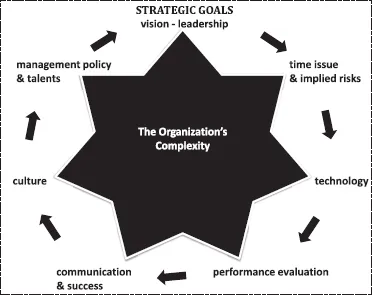![]()
1
THE EMERGENCE OF THE
RESPONSIBLE INNOVATION
CONCEPT
1. An Explanation of the Terminology
What is responsibility? What is innovation? What do they mean for organizations? In order to understand responsible innovation, each one of the term’s component parts must first be clarified. These questions lie at the heart of this chapter and can be understood through a better understanding of the roles and implications of the three actors who stand at the intersection of these two key concepts: individuals, managers and companies. From the outset, we can see that these actors are in fact complex composites: a manager is also — and first and foremost — an individual and a company is composed of a group of managers. The key question analyzed here is the different interactions between them, the transformations that blur the understanding of the stakes and roles which they each occupy in society. An individual becomes an employee, who becomes a production tool for a company. How is he then responsible? Towards whom? For what? What are the limits of this responsibility? When does it apply?
Common agreement is that innovation follows invention, where invention is the discovery of something new. Myers and Marquis (1969) provide a definition on innovation which perceives the concept of innovation not as a single action but rather as a total process of interrelated sub-processes.1 Following this definition, innovation is concerned with commercial and practical application and it covers a process in which intellectual thought is brought into practice by means of various sub-processes such as testing and prototyping, reflection on its added value among customer groups. In his book “Innovation Management,” Paul Trott2 follows this line of reasoning and states that innovation is equal to the theoretical conception plus technical invention plus commercial exploitation. That is, innovation rests upon the basic invention which needs to manifest in a commercial activity and provides value (financial, social or environmental) to the organization. Based on the inclusion of these perspectives, Trott3 defines innovation as:
Innovation, then, can manifest in various ways. Joseph Schumpeter4 was among the first to provide a comprehensive view on the typology of innovation. He argued that innovation is not only about physical change but can also manifest in terms of processes and organizational forms. Therefore, his concept of innovation covers the introduction of a new good, a new method of production, the opening of a new market, the conquest of a new source of supply of raw materials, and the introduction of a new organization. Trott5 builds on this typology and discusses the changes in various ways (see Table 1).
These innovation typologies provide direction of how responsible innovation can manifest as well. Following Table 1, we suggest that responsible innovation may be associated with each of the types of innovation. Despite the many surveys and market studies undertaken by companies prior to market launch, the innovation environment is defined by its uncertainty, making its success impossible to predict. The need by companies to minimize the uncertainty of success drives many organizations to research ways of filling this gap, with the aim of reducing the possibility of failure following launch. However, most innovators do not consider the consequences of the innovation beyond economic success while innovations that pose social and environmental pressures are often bound to fail as well. This very uncertain feature gives rise to the stakes of responsible innovation, whose essence is to question the consequences of an innovation. The management of complexity in responsible innovation is then governed by various steps in the innovation cycle. These are the leader’s strategic vision, the management of policy and talents, the corporate culture regarding innovation, technology, the evaluation of performance, the communication and success and the timing of innovation and implied risks (Figure 1).
Table 1. Types of innovation.6
Type of innovation | Example |
Product innovation | The development of a new or improved product |
Process innovation | The development of a new manufacturing process |
Organizational innovation | A new venture division; a new internal communication system; introduction of a new accounting procedure |
Management innovation | TQM (Total Quality Management) |
Production innovation | Quality circles; Just-in-time (JIT) manufacturing |
Commercial/market innovation | New financing arrangements; new sales approach |
Service innovation | Internet-based financial services |
In particular, the time issue is crucial and refers to the moment when an innovation is launched at the most favorable time to be accepted by customers. Researchers have referred to this as the problem of sinking and missing the boat.7,8 On the one hand, sinking the boat happens when the innovator enters the market too early and various flaws such as technological robustness or misunderstanding by the customer and stakeholders are detrimental to the innovation success. On the other hand, missing the boat occurs when the innovator is too late and the window of opportunity is closing. Many times this is a result of quarrelling over questions such as “Have we spent enough time on testing the product or service and checking all hypotheses to guarantee it is ‘responsible’ in terms of society?” It is this very trade-off between the fast market entry to gain short-term benefits (such as market share and profits) and the responsibility to take care of society and prevent negative impacts in the long-term which responsible-innovation deals with.
Figure 1.Analytic prism of dynamic innovation for creating value.
Different perspectives exist regarding what responsibility is, differing across disciplines and business sectors. Jeff Ubois (2009),9 provides a useful framework highlighting differing approaches to the concept of responsibility, across various sectors such as law, economics, engineering and design.
•In law, responsibility is framed in terms of liability, or proximate cause. A key question would be, if innovation builds on the work of multiple actors, how is responsibility shared among them, and who is ultimately responsible when something goes wrong?
•In economics, it is framed as externalization of costs, risks and moral hazard. To the extent that innovation creates risks, how can they be measured and assigned, particularly when there is potential for irreversible consequences?
•Engineers and medical professionals may operate under codes of ethics or practices that address responsibility.
•Designers have searched for answers with “user centered” approaches, and argue that responsibility can rest with the end user.
•To other researchers and scientists, responsibility in innovation means avoiding liability, protecting subjects of research and addressing issues of agency and unintended consequences.
Adapted from Jeff Ubois.10
2. Exploring the Notion of Responsibility
Whether you are an employee, a citizen, an association, or a company, the notion of responsibility is complex, not only because it involves others, but also because it forces different dimensions to structure themselves around each other within one individual, an individual who is both a citizen and manager.
It has previously been mentioned that the notion of responsibility is linked to the notion of being held accountable for one’s actions. Yet, an individual cannot be held accountable for his actions if he himself is not totally free to control them. For example, in an economic context in which the labor market is tense, employees are not totally free to accept or reject certain prerogatives imposed by management.
Even if we cannot be free and independent within civil society, to what extent are we free in our professional life? As managers, is it possible to maintain the responsibilities that, as citizens, we must accept? The hierarchical structures, the administrative and operational organization of companies can difficultly articulate themselves around the total freedom required for true responsibility.
a. Permeability between the private and public spheres
It is in this context thus, that the question of private vs. professional sphere arises, for innovation in general and innovators in particular.
For several years now, western companies — and governments — have relentlessly been promoting the need for a clear separation between professional and personal life, the famous “work/life balance.” Their declared goal is to ensure that individuals are not troubled in their personal life by their professional life. At the same time, however, a possible consequence of this philosophy is the risk of an unawareness or voluntary denial of the impact of one on the other. In other words, expecting a manager to be a citizen who does not think about work, implies that it is also expected of him to strictly limit himself to his professional life when he is at the office, i.e. that the manager gives up his “citizenship” when he enters the building. Among other consequences, this dichotomy entitles managers to act, first and foremost, in the interest of the firm and not in the interest of society. Indeed to what extent do managers wonder: “I have here an innovation which could be successful and thus good for the firm, its success could even earn me a promotion. Should I give up on it because it has negative impacts?” This leads to a disparity between power, concern and care, which leads to possible conflicts for the manager. How can this question be answered? Should managers base judgment on their personal values? Their moral standards? Yet, values and moral principles are very difficult to determine in a universal way.11 Asian and African standards of morality are very different, and for example, moral sensitiviti...

